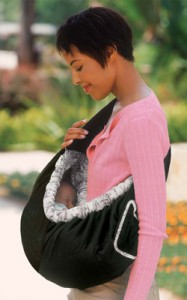There are many different baby carriers and slings available, with something suitable for every parent’s style. This guide will help you find a carrier to suit you.Â
Babywearing is a new skill that may require a little time, practice and often a little help to master, but other parents are always available online and locally to assist. See Slingmeet.co.uk Â
Most of the carriers listed here can do a range of different positions and ages – front, back, hip and newborn to 3 or 4 years.Â
Success with using them comes down to personal preference, body shape and a little perseverance or help.Â
Pouch
A pouch is a tube of material worn over one shoulder to create a pocket for baby to lie or sit in. Great for new parents and newborns because of their simplicity, but less adjustable.Â
- easy to use
- limited adjustability
- custom fit – pouch needs to fit you, so probably won’t fit both parents
- less comfortable for longer periods or with a heavier child
Some pouches are non-adjustable, others have zips or poppers to give more adjustability.Â
Ring sling
A ring sling is a rectangle of material with rings sewn in at one end. Worn over one shoulder it forms a pouch in which baby lies or sits and is adjusted using the rings.Â
-
versatile
-
very adjustable for exact fit so can be used by different sized adults
-
some learning curve for adjusting using the rings
-
may be less comfortable for longer periods or with a heavier child
Padded ring slings may be easier to learn, but an unpadded ring sling allows for greater adjustability and more versatility. Â
Wrap
A wrap is a rectangle of material, wrapped around you and baby and tied. Wraps come in a variety of widths and lengths, and are usually worn over both shouldersÂ
-
versatile – front, back and hip carries
-
comfortable for long periods and heavier babies or toddlers
-
 very adjustable for exact fit and can be used by different sized adults
-
 more of a learning curve than some carriers
 Stretchy wraps are easier with a newborn, whereas woven wraps are more supportive for a heavier child.Â
Â
Asian baby carrier and soft structured carrier
An asian baby carrier (ABC) is a soft carrier with a rectangular body and straps, fastened by tying or buckles. A structured soft carriers has buckles and more padding. Â
-
easy to learn
-
comfortable for long periods or with a heavier child
-
 one size can be used by different sized adults
-
 great for back carries
-
 more suitable for babies with good head control
The mei-tai is the most common ABC, with four straps and ties around the waist.Â
Framed carriers
A framed carrier has a structured metal or padded frame like a rucksack, padded shoulder straps and a waist belt.
- suitable for 6 months+
- back carries only
- may incorporate storage space
- needs to fit well to carry weight evenly
A framed carrier needs to fit well in the same way as a well-fitted rucksack. Some models hold baby away from your body, making child seem heavier and affecting your balance. But a well fitted one can be very comfortable for long periods, with a heavy baby.




